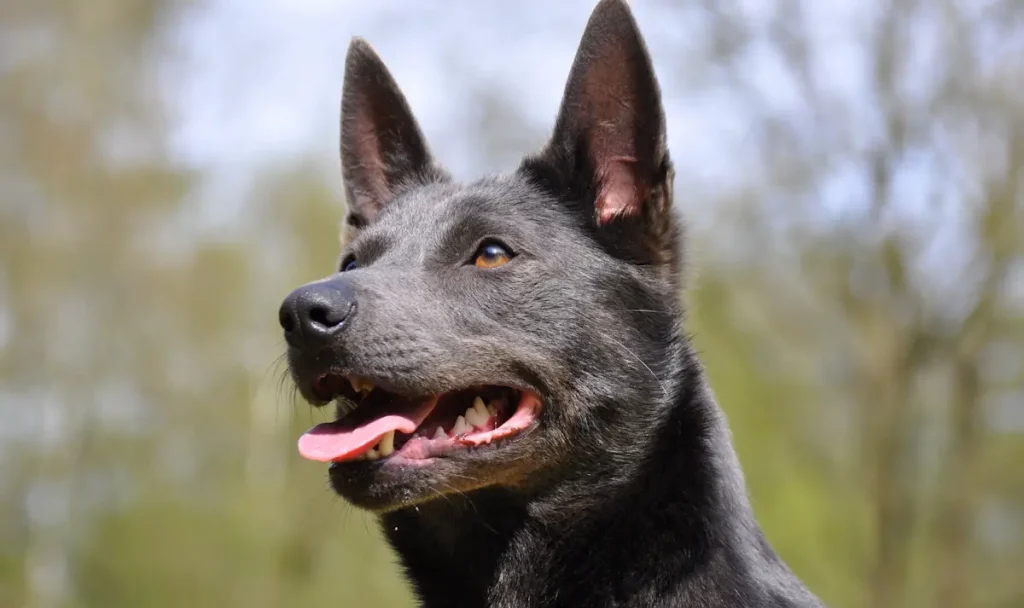Keenly keyed into their surroundings, Australian Kelpies command a presence that’s as practical as it is profound. You might find yourself drawn to their boundless energy and sharp intelligence, traits that make them ideal for the rigorous demands of herding. With a heritage steeped in stock work, these dogs are not just workers; they become partners, syncing seamlessly with the rhythms of farm life.
Their temperament, a blend of fierce independence and unwavering loyalty, may raise the question of how they fare beyond the paddock’s parameters. As you consider the intricate dance between a Kelpie’s work and play, you’ll uncover how their herding skills translate into everyday life and whether their spirited nature suits your world.
- Noise Level
- Energy
- Sociability
- Trainability
- Care
- Health
Overall
Summary
The Australian Kelpie is a highly energetic breed with a moderate noise level. They are generally sociable and trainable, requiring moderate care and maintaining good health overall.
Australian Kelpie: Traits, Temperament, and Care Guide
You must recognize the Australian Kelpie’s traits, such as their high intelligence and need for constant stimulation, to prevent negative behaviors stemming from boredom.
Their temperament is characterized by loyalty and affection within the family unit, yet they may show reserve towards strangers, necessitating early and consistent socialization.
For optimal care, you’ll need to provide regular health screenings, a well-balanced diet, and sufficient physical activity to mitigate the risk of genetic disorders and maintain their well-being.
Understanding the Unique Characteristics of Australian Kelpie
Delving into the unique characteristics of the Australian Kelpie, one finds a breed that embodies a blend of sharp intelligence, tireless energy, and a fervent herding instinct, necessitating a thoughtful approach to their training and overall care.
Your Kelpie’s athletic build demands rigorous exercise and mental stimulation to channel their high energy and independent thinking.
Cultivate their intelligent herding skills with consistent training—integral for their psychological well-being.
Exploring the Characteristics of the Australian Kelpie
While Australian Kelpies exhibit a strong affinity for herding, their medium size, weight between 35-45 pounds, and a lifespan of 10-14 years underscore their physical attributes as a breed.
| Trait | Detail | Relevance |
|---|---|---|
| Size | Medium | Suited for agility |
| Weight | 35-45 pounds | Optimal for endurance |
| Lifespan | 10-14 years | Reflects robust nature |
| Energy Levels | High | Need lots of exercise |
| Herding Instinct | Innate | Valued by Australian farmers |
Australian Kelpie: A Comprehensive Profile and Guide
You’ll find that understanding the Australian Kelpie’s comprehensive profile necessitates examining their hereditary traits, behaviors, and physical attributes.
Their herding lineage imparts a robust work ethic and a propensity for high energy expenditure, which is critical to consider for potential owners.
Analyzing their adaptability to various living environments and socialization needs offers insights into their overall temperament and compatibility with different family dynamics.
Everything You Need to Know
Understanding the Australian Kelpie requires a comprehensive look at their behavioral traits, physical characteristics, and care requirements to appreciate what makes this breed an ideal companion for the right owner. Key aspects to consider:
- Rigorous exercise needs for this working breed
- Specialized training for their herding skills
- Monitoring for health issues, including PRA
As a member of the herding dogs category recognized by the American Kennel Club, Australian Kelpies excel with active engagement.

Discovering the Temperament of Australian Kelpie
The Australian Kelpie exhibits a temperament that aligns with its herding heritage. It showcases an affectionate yet reserved nature, alongside a pronounced herding instinct and a need for consistent mental engagement.
This energetic dog is eager to please, versatile, and good with children. However, it requires an owner who will provide plenty of exercise and positive reinforcement. Their herding skills demand a leader who can channel their intelligence and independence constructively.
Australian Kelpie: Is It a Good Fit for Families?
You may be considering an Australian Kelpie for your family, assessing whether its temperament aligns with domestic life and the needs of children.
The breed’s inherent affection towards family members and compatibility with active children are counterbalanced by its intense need for stimulation, which, if unmet, leads to undesirable behaviors.
Advanced training regimes are vital to integrate their herding instincts positively into family dynamics, ensuring that the Kelpie’s mental and physical energies are constructively channeled.
Assessing Australian Kelpie’s Compatibility with Families and Kids
Assessing the Australian Kelpie’s compatibility with families and children requires careful consideration of its strong herding instincts and need for consistent training. When considering an Australian Kelpie, reflect on these key attributes:
- Enough exercise: Essential for them to stay healthy and avoid becoming destructive.
- High-quality food: Promotes well-being and energy management.
- Family dynamics: Kelpies can be found getting along well with active families that provide structure and engagement.
Kelpie Climate Versatility
Renowned for their remarkable adaptability, Australian Kelpies thrive in a multitude of climates. They boast a weather-resistant coat that equips them to handle both the searing heat of the outback and the biting cold of more temperate regions.
As a versatile dog breed, Kelpies excel in herding sheep across varying landscapes. Their resilience underscores the necessity for vigorous exercise, which fortifies their aptitude for diverse environmental challenges.
Kelpie Obedience Techniques
You’ll find that employing positive reinforcement, such as clicker training, enhances the Kelpie’s learning curve due to its reliance on immediate rewards for correct behavior.
Consistent, firm leadership is essential in managing their independent nature and ensuring their compliance with commands.
Introducing advanced obedience or agility training not only utilizes their high intelligence but also helps in expending their abundant energy, preventing the onset of boredom-induced destructive behaviors.
Effective Training Strategies
Harnessing the Australian Kelpie’s keen intellect requires a strategic approach to training, utilizing positive reinforcement techniques such as clicker training to enhance obedience and agility.
| Training Focus | Description |
|---|---|
| Positive Reinforcement | Use clicker training to reward desired behaviors, reinforcing Kelpies’ natural tendencies. |
| Mental Stimulation | Provide puzzles and tasks to satisfy their need for mental engagement. |
| Leadership | Establish firm, consistent commands to guide their willful nature. |
| Socialization | Introduce varied scenarios to foster adaptability and manage independence. |
| Early Training | Begin sessions young to capitalize on their eagerness to learn new tricks. |
Your Kelpie, bred for working, will take to training with the right amount of exercise and consistent leadership, ensuring they’re not high maintenance but a joy to teach.
Australian Kelpie Exercise and Grooming Needs
Australian Kelpies demand a rigorous exercise regimen, including activities like jogging, hiking, and herding, to channel their abundant energy efficiently. As a working breed, they need a lot of exercise to prevent boredom and maintain health. Covering long distances is intrinsic to their stamina.
Grooming is straightforward; weekly brushing mitigates shedding. A high-quality diet, tailored to their activity level and monitored for conditions like hip dysplasia, is essential. United Kennel guidelines recommend regular vet consultations.

Health Considerations for Australian Kelpie
As you consider the Australian Kelpie’s health, it’s important to recognize their susceptibility to certain hereditary conditions, such as Hip Dysplasia and Progressive Retinal Atrophy.
These ailments can significantly impact their quality of life and longevity, which typically ranges from 10 to 14 years.
A proactive approach to their healthcare, including regular veterinary check-ups and genetic screening, can help manage these risks and ensure a healthier life for your Kelpie.
Common Health Issues and Lifespan
When considering the health and longevity of your Australian Kelpie, it’s important to note that while they typically enjoy a lifespan of 10-14 years, they’re genetically predisposed to certain health conditions. These conditions include Cryptorchidism, Hip Dysplasia, and Progressive Retinal Atrophy.
Recognized by the American care standards, your Kelpie may also face degenerative eye disorders like Collie Eye Anomaly, a developmental disorder that can lead to other health problems. Another potential health issue is elbow dysplasia.
Alternatives for Australian Kelpie: Versatile and Athletic Working Dogs
Explore these breeds if you’re drawn to the Australian Kelpie’s versatility and athleticism, perfect for those who value a hardworking and agile companion.
| Similar Dogs | Short Description |
|---|---|
| Australian Cattle Dog | A hardworking and intelligent breed, great for active owners and herding tasks. |
| Border Collie | Known for its exceptional intelligence and agility, especially in herding and dog sports. |
| Belgian Malinois | A highly trainable and versatile breed, excelling in various working roles. |
| German Shepherd | A versatile and intelligent dog, ideal for work and as a family pet. |
| Australian Shepherd | A smart and energetic breed, adept in herding and various dog sports. |
Is Australian Kelpie the Right Pet for You?
Considering the high intelligence and demanding exercise needs of the Australian Kelpie, potential owners must assess their ability to provide the consistent mental and physical stimulation this breed requires. Kelpies need a lot of exercise and tasks to channel their herding skills constructively.
If you’re considering a Kelpie as a pet, understand their temperament and commitment needed. Adopting from a shelter or rescue could offer a Kelpie in need a fitting home.
Conclusion
In conclusion, the Australian Kelpie is nothing short of a herding maestro, orchestrating livestock with unparalleled finesse. Your commitment to their physical and mental enrichment is paramount; without it, they may conduct a symphony of chaos.
Tailored obedience training and regular health checks are vital. If you’re ready for a whirlwind of energy and intelligence, the Kelpie could be the perfect addition to your family, harmonizing with your active lifestyle like a virtuoso to their craft.
Frequently Asked Questions
What Are the Skills of Australian Kelpie?
You’re examining a Kelpie’s agility, intelligence display, and stamina showcase. They’ve got a water instinct, jumping prowess, and obedience potential. Their problem-solving and responsive nature, coupled with an athletic build, really shine through.
What Is the Personality of the Australian Kelpie?
Your Australian Kelpie’s personality combines high intelligence with energetic zest. They’re devoted yet independent, showing playful antics and forming loyal bonds. Their alertness and problem-solving reflect their high stamina, making them excellent watchdogs.
Are Kelpies Hard to Train?
Kelpies aren’t hard to train, with their high intelligence and exercise needs. Consistent training, mental stimulation, and positive reinforcement are key. Obedience classes help tackle training challenges, emphasizing socialization importance and reward-based methods.
Do Australian Kelpies Bark a Lot?
Yes, Australian Kelpies can bark a lot, often due to unmet exercise needs. Effective bark training, understanding barking triggers, and teaching quiet commands are crucial for noise management and curbing their vocal tendencies.
